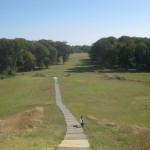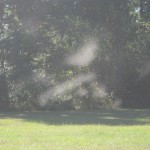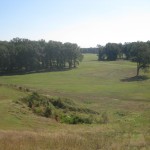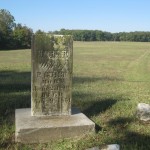On a beautiful October day, when the temperature was approaching 80, Tom and I visited Poverty Point State Historic Site and National Monument in Louisiana. Poverty Point State Historic Site was the home of some of the oldest mound building people in North America. The people who built these mounds lived in this area from 1650 BCE to 700 BCE. Poverty Point has been designated a World Heritage Site.
The Poverty Point people had an advanced civilization with elevated mounds to keep their homes above the periodic flooding in the area. They built higher mounds for protection and for community events. They were great hunters and fishers but also planted and harvested crops. They traveled up and down the Mississippi River and traded with the other native people along the route. Rocks that originated in Canada and Ohio and shells from the Gulf Coast have been found at the site.

The thing that really impressed Tom and me was the size of the area. They built six half-circle mounds, one behind another, and built their homes on these raised mounds. The diameter of the circle is 3/4 of a mile! The circle in the middle of the compound was a common area that held long poles used as a clock and calendar by the people.
The biggest mound, Mound A, was used for community ceremonies. It is laid out in the shape of a bird with outstretched wings. This mound is 70 feet in height and 710 feet from heat to tail with a 640 foot wingspan. The people moved the earth for this mound by carrying baskets weighing about 50 pounds each. It would have taken 10 million baskets-full to build the mound. Mound A is definitely the highest thing around and there was a great view from the top.
Tom and I walked the 2.6 mile trail around the site. Because the site was farmed extensively until 1970, the circular mounds are mostly plowed away. The larger mounds, however, were left alone except for natural erosion.
You might be wondering about the name. The name “Poverty Point” was taken from a nearby plantation. Plantations in the area often had similar names because it was hard to make a living on the flat soil that flooded regularly. Other plantations in the are were named “Hard Time Plantation,” and “No Mistake Plantation.”
Poverty Point State Historic Site was a very interesting place to visit. It was much larger and more elaborate than we expected.





One comment